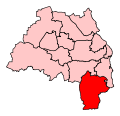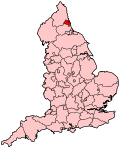Houghton and Sunderland South (UK Parliament constituency)
Houghton and Sunderland South (/ˈhoʊtən/) is a constituency[n 1] represented in the House of Commons of the UK Parliament since 2010 by Bridget Phillipson of the Labour Party.[n 2] In the 2010 and 2015 general elections, it was the first constituency to declare its result, continuing the record of its predecessor seat, Sunderland South, in the four general elections from 1992-2005. However, in the 2017 and 2019 general elections, it was beaten by Newcastle upon Tyne Central.[2]
| Houghton and Sunderland South | |
|---|---|
| Borough constituency for the House of Commons | |
 Boundary of Houghton and Sunderland South in Tyne and Wear | |
 Location of Tyne and Wear within England | |
| County | Tyne and Wear |
| Electorate | 68,828 (December 2019)[1] |
| Current constituency | |
| Created | 2010 |
| Member of Parliament | Bridget Phillipson (Labour) |
| Number of members | One |
| Created from | Sunderland South, Houghton and Washington East |
Constituency profile
Houghton and Sunderland South is a medium density inland area,[n 3] partly situated on the south banks of the River Wear, which is mostly populated by people of working age, and a minority of the population living in rural villages. The majority of the population historically relied on coal mining, steelworks and shipbuilding from the mid-nineteenth to mid-twentieth centuries on Wearside, with Tyne and Wear at the forefront of some of the earliest Labour Party activity, and several of its earliest Members of Parliament. The largest opposition vote has come from the Conservative Party.
Boundaries
The City of Sunderland wards of Copt Hill, Doxford, Hetton, Houghton, St Chad’s, Sandhill, Shiney Row, and Silksworth.
Following their review of parliamentary representation in Tyne and Wear, the Boundary Commission for England reorganised constituencies covering the City of Sunderland. Elements of the former Sunderland South and Houghton and Washington East seats were combined to create this as a new seat in 2010.
Members of Parliament
| Election | Member[3] | Party | |
|---|---|---|---|
| 2010 | Constituency created from Sunderland South and Houghton and Washington East | ||
| Bridget Phillipson | Labour | ||
Elections
Elections in the 2010s
| Party | Candidate | Votes | % | ± | |
|---|---|---|---|---|---|
| Labour | Bridget Phillipson | 16,210 | 40.7 | -18.7 | |
| Conservative | Christopher Howarth | 13,095 | 32.9 | +3.2 | |
| Brexit Party | Kevin Yuill | 6,165 | 15.5 | N/A | |
| Liberal Democrats | Paul Edgeworth | 2,319 | 5.8 | +3.6 | |
| Green | Richard Bradley | 1,125 | 2.8 | +1.0 | |
| UKIP | Richard Elvin | 897 | 2.3 | -3.4 | |
| Majority | 3,115 | 7.8 | -22.0 | ||
| Turnout | 39,811 | 57.8 | -3.1 | ||
| Labour hold | Swing | -11.0 | |||
| Party | Candidate | Votes | % | ± | |
|---|---|---|---|---|---|
| Labour | Bridget Phillipson | 24,665 | 59.5 | +4.4 | |
| Conservative | Paul Howell | 12,324 | 29.7 | +11.2 | |
| UKIP | Michael Joyce | 2,379 | 5.7 | -15.8 | |
| Liberal Democrats | Paul Edgeworth | 908 | 2.2 | +0.1 | |
| Green | Richard Bradley | 725 | 1.8 | -1.0 | |
| Independent | Michael Watson | 479 | 1.2 | N/A | |
| Majority | 12,341 | 29.8 | -3.8 | ||
| Turnout | 41,480 | 60.9 | +7.2 | ||
| Labour hold | Swing | -3.4 | |||
| Party | Candidate | Votes | % | ± | |
|---|---|---|---|---|---|
| Labour | Bridget Phillipson | 21,218 | 55.1 | +4.8 | |
| UKIP | Richard Elvin | 8,280 | 21.5 | +18.8 | |
| Conservative | Stewart Hay[8] | 7,105 | 18.5 | -2.9 | |
| Green | Alan Robinson | 1,095 | 2.8 | +2.8 | |
| Liberal Democrats | Jim Murray[9] | 791 | 2.1 | -11.8 | |
| Majority | 12,938 | 33.6 | +4.7 | ||
| Turnout | 38,489 | 56.3 | +1.0 | ||
| Labour hold | Swing | -7.0 | |||
| Party | Candidate | Votes | % | ± | |
|---|---|---|---|---|---|
| Labour | Bridget Phillipson | 19,137 | 50.3 | N/A | |
| Conservative | Robert Oliver | 8,147 | 21.4 | N/A | |
| Liberal Democrats | Christopher Boyle | 5,292 | 13.9 | N/A | |
| Independent | Colin Wakefield | 2,462 | 6.5 | N/A | |
| BNP | Karen Allen | 1,961 | 5.2 | N/A | |
| UKIP | Richard Elvin | 1,022 | 2.7 | N/A | |
| Majority | 10,990 | 28.9 | N/A | ||
| Turnout | 38,021 | 55.3 | N/A | ||
| Labour win (new seat) | |||||
Notes
- A borough constituency (for the purposes of election expenses and type of returning officer)
- As with all constituencies, the constituency elects one Member of Parliament (MP) by the first past the post system of election at least every five years.
- However it borders the coastal constituencies of Easington and Sunderland Central.
References
- "Electorate Figures – Boundary Commission for England". 2011 Electorate Figures. Boundary Commission for England. 4 March 2011. Archived from the original on 6 November 2010. Retrieved 13 March 2011.
- "Elections 2017: Declaration times in time order". Press Association. Retrieved 7 June 2017.
- Leigh Rayment's Historical List of MPs – Constituencies beginning with "H" (part 4)
- https://www.sunderland.gov.uk/media/22032/HSS-Statement-of-Persons-Nominated-General-2019/pdf/HSS_Statement_of_Persons_Nominated_-_General_2019_11_14.pdf?m=637093469968830000
- Seddon, Sean (June 9, 2017). "Houghton & Sunderland South constituency General Election results 2017". nechronicle.
- "Election Data 2015". Electoral Calculus. Archived from the original on 17 October 2015. Retrieved 17 October 2015.
- "Houghton & Sunderland South parliamentary constituency - Election 2017" – via www.bbc.co.uk.
- "Conservative Parliamentary Candidates Chosen". Sunderland. Archived from the original on 2015-02-15. Retrieved 2015-02-15.
- "list of selected candidates". Lib Dems. Retrieved 7 March 2015.
- "Election Data 2010". Electoral Calculus. Archived from the original on 26 July 2013. Retrieved 17 October 2015.
- "Archived copy". Archived from the original on 2011-06-08. Retrieved 2010-05-03.CS1 maint: archived copy as title (link)
- "BBC NEWS – Election 2010 – Houghton & Sunderland South". BBC News.